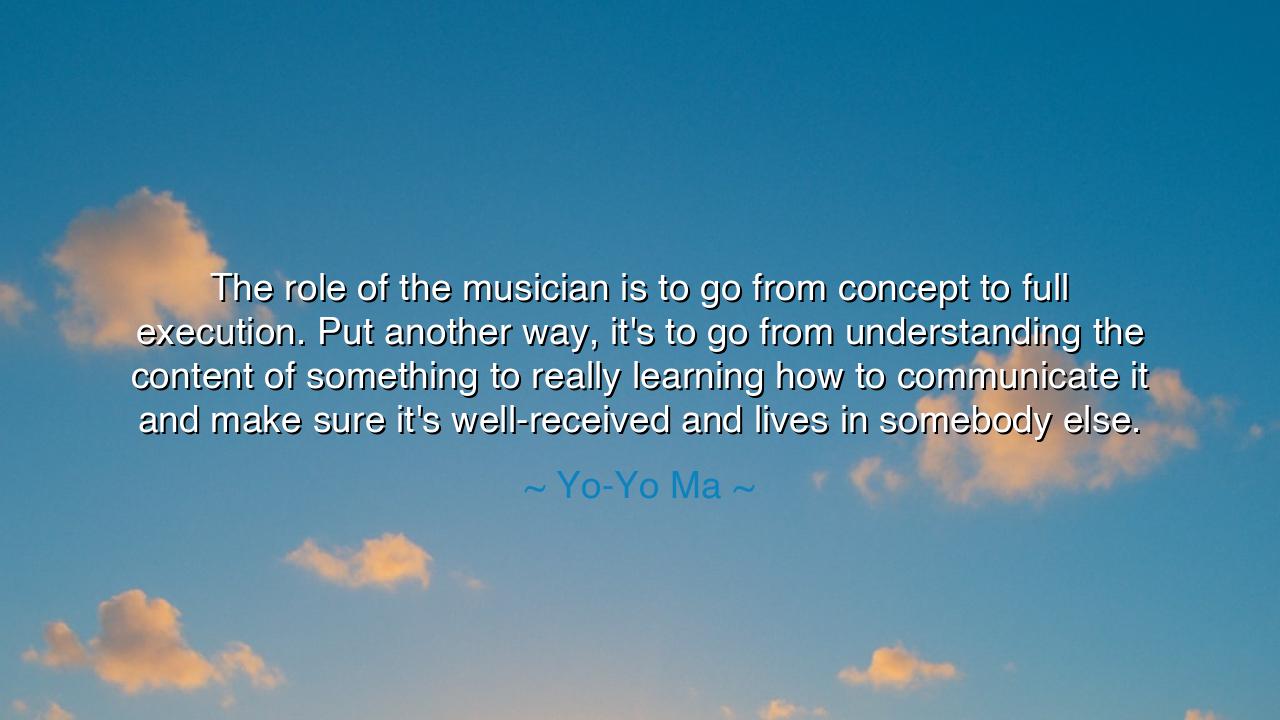
The role of the musician is to go from concept to full execution.
The role of the musician is to go from concept to full execution. Put another way, it's to go from understanding the content of something to really learning how to communicate it and make sure it's well-received and lives in somebody else.






In the councils of the elders, where craft was weighed not by fame but by fidelity, it was said: “A song is born twice—first in the maker, then in the listener.” Yo-Yo Ma’s teaching—“The role of the musician is to go from concept to full execution… from understanding the content to really communicate it and make sure it is well-received and lives in somebody else.”—restates that ancient law. He reminds us that art is not finished when the hand is tired or the score is clean; it is finished when another heart carries it away as its own. The path is long: from idea to embodiment, from private meaning to shared bread.
To speak of concept is to speak of the spark: the theme, the image, the question that arrives like dawn over a quiet field. But sparks do not warm a house. Full execution is the gathering of wood, the tending of flame, the discipline by which breath, body, and instrument become one will. Notes are not enough; posture, phrasing, silence, and courage must agree. Thus the musician moves from “I see” to “I serve,” translating vision into sound that stands upright in the world.
Yet the journey does not end at mastery. One may understand the content of a fugue, the architecture of a raga, the sorrow inside a folk tune—and still fail the deeper test: to communicate. Communication is the hospitality of art: making room for the listener without surrendering the truth of the piece. It asks the player to listen outward—hall, audience, moment—and to shape the telling so that what is offered is actually received. For music is not a monument; it is a meeting.
Consider the parable of Pablo Casals and the Bach Cello Suites. As a boy, he found the dusty book in a Barcelona shop and carried it like scripture. For over a decade he practiced in private, learning not just the content of Bach’s dances, but the breath behind them. Only when he could make their gesture speak—when the Allemande could console and the Gigue could lift—did he share them. In that sharing, the Suites crossed from page to pulse; they became, at last, well-received and came to live in somebody else. This is the arc Yo-Yo Ma describes: study ripened into service, and service into a living tradition.
There is also the witness of communities transformed by song. A lullaby taught to a frightened child, a hymn carried through grief, a street melody that gathers strangers under the same rhythm—here the musician’s work is complete, for the music travels without its maker. The notes become memory, the memory becomes strength, and the strength returns to the world as patience and hope. When art truly lives in somebody else, it multiplies unseen: it changes choices, tempers anger, opens the hand.
From this, take a clear lesson: technique is a gate, not a garden. Practice until the fingers forget themselves, theory until form turns into freedom—but then cross the gate. Ask not only “What did I play?” but “What did they hear? What did it do to them?” Let rehearsal include the audience in your imagination; let interpretation bend toward clarity and generosity. Precision without presence is a polished shell; presence without precision is a well-meant blur. The calling is the union of both.
Now let counsel become craft. For the student: begin each piece by naming its concept in one sentence; end each day by testing whether your playing tells that sentence without words. For the ensemble: rehearse dynamics as dialogue, not volume—who asks, who answers, who blesses the silence. For the seasoned artist: carry field notes from concerts—where did breath align, where did attention waver, what gesture opened the room? For all: practice the arts of address—story before sound, context before climax—so that meaning can find its bridge to the ear. In these ways, you travel the road from understanding to communication, from mastery to mercy.
And finally, remember the elder charge: leave your music with them. Choose tempos that allow the heart to walk beside you; shape endings that release rather than impress; honor simplicity where it is truer than brilliance. If you do this, your work will not stop at applause. It will pass the final test Yo-Yo Ma names: it will be well-received—and then it will abide where all durable art abides, living in somebody else, changing the weather of their days long after the last note has vanished into air.






AAdministratorAdministrator
Welcome, honored guests. Please leave a comment, we will respond soon